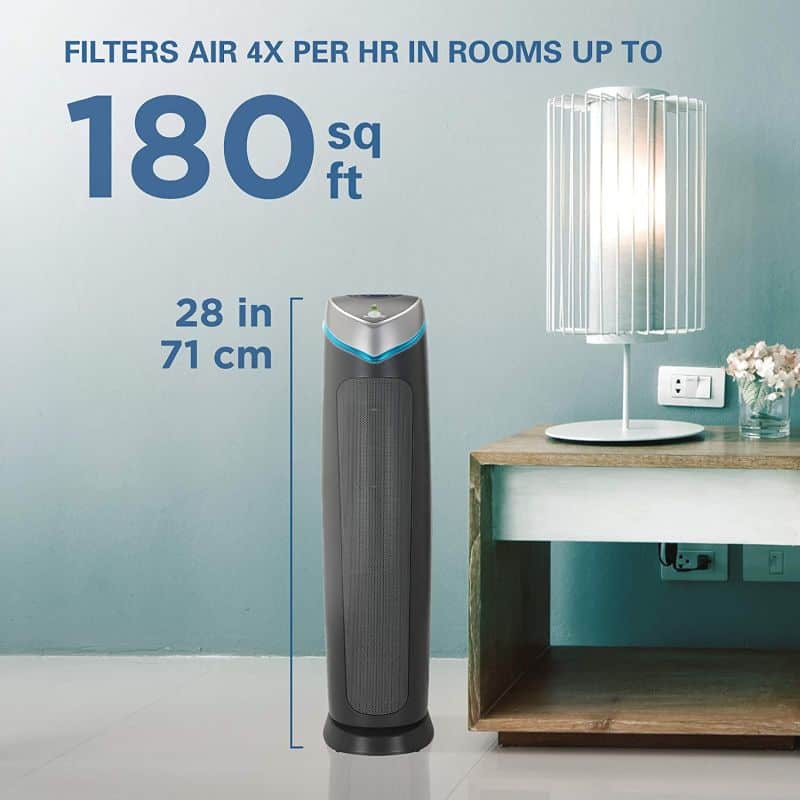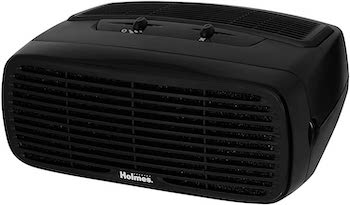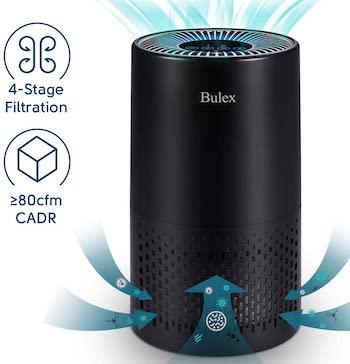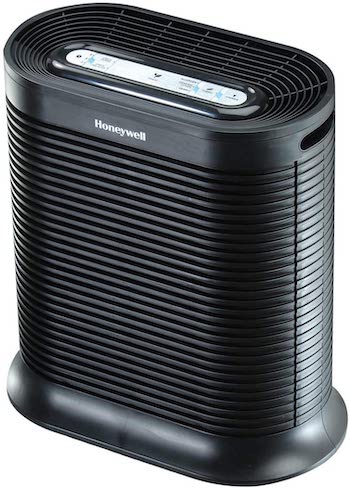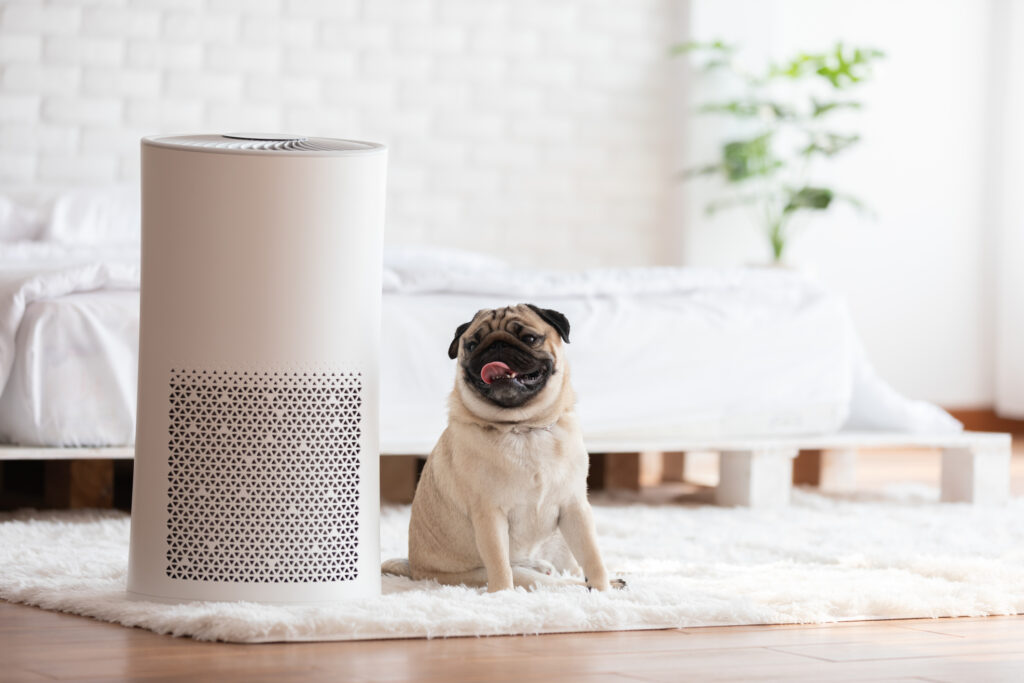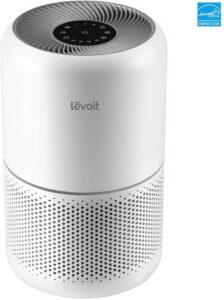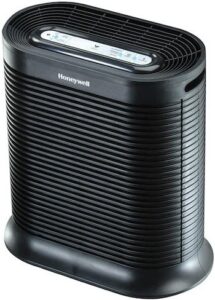5 Best Air Purifiers for Your Bedroom to Improve Air Quality And Sleep
Summer has finally arrived where we’re from, and we couldn’t be more thrilled about that! With the arrival of summer, however, we do also have to deal with allergy season each year. Our seasonal and environmental allergies are quite bad indeed, especially when certain things bloom outside, so we’re always on the lookout for new ways to help get them under control besides just dosing ourselves with allergy medication regularly. That’s how we originally came across a recommendation for air purifiers! Of course, we’d heard of these things before, as well as all of their different perks, but we weren’t actually aware until recently of just how fantastic they can be for allergies specifically.
That’s how we found ourselves researching air purifiers a little more extensively. Doing a bit of research and learning a little more about anything you’re considering investing in is a great tactic for making sure that your money really goes towards the right purchases. It also helps to ensure that your needs are actually met. To get you started off, here’s some of what we learned in our own research (but always make sure that you do a little bit of your own too)!
What is an air purifier?
Much like an air humidifier, an air purifier is a small, electrically run household appliance that alters, improves, and maintains the air quality in your space. Air purifiers remove contaminants from the air in indoor spaces to make it more fresh and clean to breathe. Depending on the kind of air purifier you purchase, modern units are often space-efficient, digital and simple to run, easy to clean and maintain, and also light and portable so you can move them around your home.
How do air purifiers work?
Simply put, air purifiers sanitize the air around the units by ridding it of allergens, toxins, and pollutants. Whereas, say, an essential oil diffuser uses fans to blow steam containing scented particles out in order to add those particles into the air around the room, an air purifier does the opposite. These machines use fans to bring air from the room in, pass it through a filter to remove polluting particles, but thenalso complete an extra step in which the air is actually sanitized. In this step, negative ions are emitted by the inner workings of the purifier to balance out positive ions present in the air from those removed pollutants, effectively neutralizing the air before another fan sends it back out into the room again. As the machine completes a full cycle, it circulates healthy, clean air across and around the space and eliminates present toxins throughout.
Who should buy an air purifier and why?
While anyone at all can absolutely benefit from the use of an air purifier, they’re actually of particular use for people with pre-existing conditions related to their respiratory systems, or even those who suffer from things like smell-based migraine triggers. Air purifiers can:
- Eliminates odors
- Clear toxins from cigarette smoke
- Filter out potentially harmful mold particles
- Dissipate and get rid of strong odors and particles from strong indoor toxins like cleaning products
- Filter out allergens and things like pollen particles that are causing sneezing, wheezing, or itchy eyes
Best Air Purifiers for Your Bedroom
Are you pretty convinced that an air purifier would be a great investment for you, but you also feel like you could still use a little bit of guidance when it comes to the models and brands that are available themselves? Then we hope you’ll check out this pros and cons style outline we made for the top five brands we came across in our own search!
1. Levoit Air Purifier for Home
If your primary concerns in needing an air purifier are dust, pollen, and the smoke from the balcony below your apartment that sometimes drifts in through your open window, thenLevoit is the purifier for you. Besides being incredibly powerful for its nearly miniature size, this purifier comes with specific guidance for finding both the best on-brand replacement filters at the best price and also quality alternatives that will still do your machine justice. The specially designed inner system covers up to 219 square feet around the machine and is basically silent. Inside, an ultra-fine basic HEPA filterand an activated carbon pre-filter are at work for you together in one appliance. This machine is also ozone-free and certified by several accredited air quality safety boards. The filter is digitally set with several simple timed settings and very easy to work and navigate.
Despite the fact that previous buyers mostly raved about the actual function and quality of results that this little air purifier provides, there is one recurring detail that’s worth noting, particularly if you are smell sensitive or have odour based migraine triggers. Some people noticed that a decently heavy plastic smell emitted from their purifier for the first few uses and it bothered them enough to be noticeable. Luckily, however, they all reported the machine as still being worth the investment because the smell goes away after the first week or so.
Pros:
- Eliminates smoke, dust, and pollen
- Combination HEPA filterand activated carbon pre-filter
- Small size, very portable, easy digital settings to navigate
- Silent running system
- Ozone free
Cons:
- The first few uses might put out a temporary plastic smell that wears off shortly but is definitely noticeable intially
2. Honeywell HPA200 True HEPA Allergen Remover
If you don’t mind having a slightly larger machine (in fact, some people prefer the power that bigger sizes usually come with) and your main goal in purchasing a purifier is to eliminate allergens, thenHoneywell might have the best model for you. This HEPA filter air purifier is designed for larger spaces, capturing around 99.97% of pollutants in spaces up to 310 square feet. It is equipped to eliminate airborne particles as small as microbes. The purifier runs very quietly, operates on simple commands thanks to a digital tap-button system, and has an auto-off timer. In addition to handling things like dust and pet dander, it’s also very effective when it comes to eliminating smells. Finally, it’s specifically designed to actually circulates the airas it neutralizes, making sure it really gets everything in the room. It can circulate the air up to five times an hour on any cleaning setting.
Most people who have experience with using this purifier were very pleased indeed with both its functionsand the results they got out of it. There were two points, however, on which the machine has received a bit of criticism. The first is that some people noticed a slightly chemical smell the first few times they ran the purifier. While this purifier doesnot release harmful chemicals into your airspace, some units do hold onto the factory smells from the making of the filter for a couple of weeks. Finally, some people found the filter a little bit of a learning curve to replace properly after cleaning; they reviewed it as being easy to put in accidentally loose, which will be less effective. You really have to make sure you get it into place just right.
Pros:
- Caputres 99.97% of present air pollutants
- Can circulate air in a space of up to 310 square feet effectively
- Circulates air in a small to medium sized indoor space up to five times an hour
- Neutralizes pollutants as small as microbes
Cons:
- Some units come with a slight leftover chemical smell from filter manufacturing that goes away in a couple of weeks
- Slight learning curve in replacing the filter just right so it isn’t loose while the purifier runs
3. Bulex HEPA Air Purifier Air Purifier with True HEPA Filter
If you’re still feeling very interested in investing in a smaller model but you’re also hoping to find one that’s a little more stacked in terms of its features, you might prefer this unit sold byBulex. This little countertop purifier is a bit more of an investment, but that’s because it actually filters in four distinct stages. Its combination of HEPA and activated carbon filters can capture anything from pet dander to odours to tiny microbes, setting a new standard for home machines. The fans and motor are designed with high efficiency but also higher torque, giving it more power with less energy use while still running silently. The touch-settings are simple, timers are easy to set, auto-off, and sleep modes give you purifying cycles on a schedule that works for you, and the blue LED light in the top even works as a night light.
The only complaint that this air purifier has ever received is that its “off” beep is louder than some other models when it switches from running to auto-off or sleep modes. If that’s a detail you can live with, then the only other real point of consideration is the price. This model won’t break the bank, but itis slightly closer to the expensive end of the scale as far as our list goes since itdoes provide four filtration steps.
Pros:
- Small, lightweight countertop design
- Easy to use digital settings, auto-off and sleep modes, and tap buttons
- Four-stage filtration system made from a combination of HEPA and activated carbon filters
- Bonus LED night light feature
Cons:
- Loud beep on completion of scheduled cycle
- Slightly more expensive than some other models of a similar size
4. Holmes Small Room 3-Speed HEPA-Type Air Purifier with Optional Ionizer
If you’re working with a much smaller space, or even looking for something that’s on the cheaper end for your budget but still works, you might get along better with this small room purifier fromHolmes. This slightly more simplified machine also falls into the HEPA filter category in its basic functions, able to remove 99% of pollutants from the air and eliminate particles as small as microbes. It includes three cleaning speeds, including a lower, quieter setting that works for continuous air cleaning while you’re home and a higher powered, faster filtration setting that will make a little more noise but is great for getting ahead on purification while you’re out. The purifier covers up to 109 square feet and works just as well whether you place it horizontally or vertically. It also has an optional ionizer that you can turn on for extra purifying during allergy seasons or in case of extra odour, like cleaning.
While this little machine actually hasn’t received any real complaints regarding its basic functions and is usually praised for its power versus its size, a few people have been skeptical about how impactful the ionizer is specifically. They found that it lacked the “fresh air” smell that they’d experienced after using other ionizing air purifiers, but the feature was quiet, didn’t inhibit any other function, and definitely didn’t have any detriment, so it was still an effective purchase.
Pros:
- HEPA filter purifier that removes 99% of pollutants (including microbes) in up to 109 square feet of space
- Very space-efficient and works whether you place it horizontally or vertically
- Optional ionizer for extra and alternative filtration during allergy season or cleaning
- Three-speed settings suitable for different circumstances
Cons:
- Ionizer’s effect has been debated by previous buyers (who still recommend the whole system overall)
5. Germ Guardian True HEPA Filter Air Purifier for Home
If you just haven’t seen a design that’squite larger and powerful enough for the space you’re hoping to purify, then here’s one last model for your consideration, this time from Guardian Technologies. This appliance contains a 3-in-1 system that uses a HEPA filter, an activated carbon filter, and even a small UV light to tackle up to 99% of pollutants, including everything from large visible particles like allergens to microbe-sized germs (and also including odours). Purifiers with UV lights can even kill airborne viruses, making this an ideal choice for flu season. The appliance has three-speed settings and quiet function; there is some sound, but it was specifically designed to sound like the calming white noise effect that some people actually buy machines for, encouraging gentle, relaxing sleep while completing a purifying cycle. The machine can tackle up to 167 square feet in total.
It’s worth noting that, even though the function of the appliance is actually quite well-reviewed, some previous buyers had one important point of caution to offer. When running the purifier on its highest setting with the UV light featured also switched on, it’s important that you keep an eye on the time. This should only be done for short periods of time because the combination of high-powered systems all working at once in this scenario can cause overheating, as well as a slightly burning smell that worried some people. Following the recommendations for combined features and run times in the instruction manual is important, so overworking the systems can be avoided.
Pros:
- 167 square foot reach with 99% effectiveness for particles of all sizes
- 3-in-1 combination system includes HEPA filter, activated carbon filter, and UV light
- Designed with three-speed settings and a calming white noise effect
Cons:
- Lengthy use on highest speed setting with UV light switched on risks overheating and burning smell in some units
Types of air purifiers
There are actually five different types of basic air purifiers that are generally sold in regular stores and made affordable for home use. Each one is effective and capable, but they have different functions, benefits, and price points, so it’s important to learn a little bit about them before you make your purchase, just to make sure that you’ll really get the best type for your specific needs. The types of air purifiers are:
- Basic HEPA filters: This is the most common type of air purifier for home use. HEPA filters are made from (sometimes a mixture of) foam, fibreglass, cotton, or other effectively particle-trapping materials and textiles. The air brought into the machine by the fan passes through the filter, which traps any polluting particles so that the air can move out into the room again free of them.
- Electrostatic filters:Electrostatic filters work by charging the particles that are in the air in order to neutralize them. Once those particles are charged, this kind of purifier filters the particles out of the stream by collecting them and keeping them inside the appliance. This might not be a process you can actually see very well, but it still requires you to simply remove the trapping filters and give them a quick wash every now and then to clear them. This processdoes produce ozone, which is usually imperceptible and not harmful but can cause discomfort for people with respiratory issues in the simple way it varies from the rest of the air in the room.
- Ionizers, or ozone generators: Ionizers and ozone generators are actually twoseparate types of air purifiers, but the manner in which they work is so similar that they’re easily explained together. The very simple difference lies in the kinds of particles they produce; ionizers create ions while ozone generators create ozone. Each of these kinds of particles has a positive charge, while the pollutant particles in the air have a neutral charge. When the air is brought into the purifier, those neutral particles are met with the positive particles inside, and their own charge changes to positive as well. When the air is pushed out again, these particles are not kept inside like above. Instead, they are pushed out as well, only now their positive charge causes them to stick imperceptibly to objects and surfaces in the room, rather than floating around the room in the air to be breathed in. Keep in mind, once again, that a purifier that creates ozonecan irritate people with respiratory conditions, so another choice might be best.
- Activated carbon filters: In reality, activated carbon filters are actually something that most people use in combination with another type of air purifier so that the different kind can catch anything this filter won’t, giving you a more thorough effect than any singular machine. Activated carbon filters use a carbon material that is porous enough to let the air pass through, but not so much that pollutants can go with it; these become trapped in the carbon’s pores. These filters are particularly effective for removing odours and gasses from the air, and some heavy-duty models will also trap larger particles or volatile organic compounds. If the air purifier you already have isn’t tackling smells in the air effectively enough for you, team it up with an activated carbon filter so it’s fresh smelling and clean.
- UV lights: Air purifiers that use UV lights are actually germicidal. Where other kinds of purifiers are often only capable of tackling larger particles, those with UV lights in them are often strong enough to eliminate microbes and sometimes even viruses. It’s worth noting, however, that this kind of purifier is not usually manufactured and sold as a small, standalone appliance. Instead, except in select cases, these systems usually have to be installed in your home’s actual HVAC system. They’re usually put right over coils and other parts where things like damp mustiness, mould, and other particles might grow. Some people have a second UV light piece installed over the final fan for extra germ elimination before the air re-enters your space.
Pairing air purifiers together
If you’re a person who lives near or works with lots of air contaminating elements, or you’re a chronically ill person trying to mitigate irritants and exacerbating factors on your ability to breathe, sometimes purchasing two air purifiers is better than one. Many people who require as clean an air quality as possible will purchase a filter-based purifier that takes care of odours and large particles and then also set up an ion-based machine to handle some of the smaller particles in their space.
Air purifier care
Caring for your air purifier is a process that depends quite heavily on which model and type you buy. Some of them require the cleaning or changing of air filters, while others are all made of permanent internal systems that don’t need to be changed. In those cases, all you’ll have to do is dust the machine when necessary to ensure that it’s sucking in only air and not unnecessary extra particles that can be easily wiped away instead. Most air purifiers are specifically designed to be quite heavy-duty so that they can run for long periods of time and really properly clear out the entire room. Be sure to read the user manual that your specific type, make, and model comes with in order to learn how to care for and change or clean its different parts and pieces properly.
Do you know someone else who has been thinking about investing in a new air purifier of their own, but you’re also pretty sure they could use some extra guidance too? Share this post with them so they have all kinds of information to work with and options to consider!
